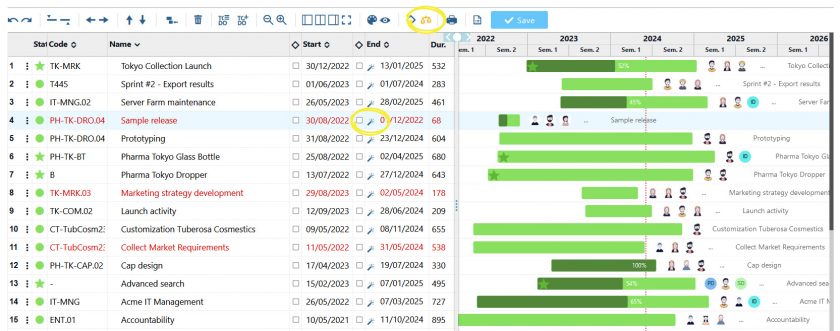Twproject is a powerful and versatile tool that simplifies the management of multiple projects simultaneously through an intuitive Portfolio dashboard. You can monitor the health status of all your projects at a glance, allowing you to always keep the key progress metrics under control.
In portfolio management, Twproject offers a range of methodologies and tools that help you coordinate and clearly define the activities across the entire portfolio.
One of the most important aspects of project management is ensuring that daily work is closely aligned with the company’s strategic objectives. Twproject helps you achieve this by providing tools that allow you to define a clear and well-structured action plan that reflects company priorities.
Check out this dedicated tutorial video!
Overview of any planning issue
Twproject has a powerful and precise filter management applied to several functions of the platform. Even for Portfolio Management, filters help you select and display projects with an incredible variety of choices.
The filters can be combined with each other and refer to the three main areas of data, i.e. those relating to the project (type, budget, characteristics, etc.), the timeframe (duration, relevant dates, etc.) and the resources involved.

There is a default filter in the main search bar, but it is possible to save new customised configurations and even to define a specific filter as the default selection.
A good use of filters therefore meets the first requirement of Portfolio Management, namely to have an overview of specific areas or groups of projects.
In addition to the classic Portfolio view, it is also possible to filter in the statistics dashboard to get an overview of the performance of selected projects by different progress factors.
Financial management
In order to calculate the ROI and see which business objectives have been met, it is also important to keep an eye on the project budget when it comes to Portfolio Management.
Among the filters that Twproject provides, the ‘Budget overflow‘ filter is very useful, allowing you to select all projects that are experiencing financial difficulties.
This will allow us not to perpetuate the error and to take the necessary corrective action.
Furthermore, in the classic Portfolio view, which in Twproject is represented by a large global Gantt chart, we have the ‘Financial Data‘ command.
This function will allow each project in the list to be paired with its financial report, relating the budget with estimated and actual costs.

Such a view is very useful for carrying out cash flow analyses and evaluating the highest-performing projects at a glance.
In fact, financial management in Portfolio Management helps measure the value created by each project and make decisions on the most profitable investment areas.
Relevance among projects
After measuring the performance of projects, it is important that the digital tool allows the priority that each project has over the others to be set.
Twproject allows you to assign a relevance value to projects and this value can be defined and displayed in the Portfolio.
We can sort projects according to increasing or decreasing relevance so that timing and allocations can also be redefined according to this criterion.

Indeed, through the Portfolio, you can easily reschedule the start and end dates of projects and relate them to the overall timeline.
For example, a less relevant project can be moved later in time, choosing to give priority to other, more beneficial projects.
Resource management and allocation
Furthermore, an important function of Portfolio Management is the distribution of the workload between different projects, also according to their strategic and economic relevance.
Indeed, it is useful that the efforts of resources are well distributed, but also well focused on the projects that have the highest priority, both in terms of timing and strategic relevance.
This level of priority is only detectable, as we have seen, with the Portfolio Management activity.
Twproject takes this a step further and allows you to redistribute the load in an intelligent and thoughtful manner, with just one click.
Here is how you can do it with this simple trick:
- From the main view of the Portfolio, see which of your resources are overloaded with the ‘show/hide workload’ icon (scale).
- Secondly, filter the projects by assignee, limiting the view to those in which the overloaded resource (or resources) is included.
- After filtering, arrange the obtained projects according to order of relevance.
- Finally, use the command ‘optimise end date by resource capacity’ (the magic wand) on the project with the lowest relevance: the dates of the latter will be extended until an optimal load for the person involved is reached.

Strategic planning that takes these factors into account increases corporate welfare and the satisfaction of the entire team.
As well as, of course, optimising overall productivity levels.
Project porfolio statistic
Ultimately, the shareability of Portfolio Management functions also to facilitate group communication and ensure that all parties involved in projects are coordinated with each other
It is crucial to provide regular reports on the progress of the entire portfolio and its sustainability in relation to the company’s objectives.
The Portfolio statistics dashboard in Twproject shows the overall status of the work, with graphs and insights updated in real time. We can filter this data for any need, as already seen, and easily export it in various formats for full sharing.

In addition, on the main page of Portfolio, you can put information on the status of ToDos next to each project line, thanks to the ‘ToDo Data’ command.
Knowing the status of activities for each project is very useful for planning purposes, but also for sharing the up-to-date situation with the resources involved, in a cohesive effort to achieve objectives.
Indeed, creating a collaborative environment for a faster exchange of information is one of the objectives of Portfolio Management, with the ultimate goal of smoothing the planning of activities and their monitoring.